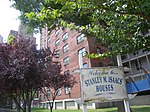American Society for the Prevention of Cruelty to Animals
1866 establishments in New York (state)Animal charities based in the United StatesAnimal rights organizationsAnimal welfare organizations based in the United StatesCharities based in New York City ... and 2 more
Cruelty to animalsOrganizations established in 1866
The American Society for the Prevention of Cruelty to Animals (ASPCA) is a non-profit organization dedicated to preventing animal cruelty. Based in New York City since its inception in 1866, the organization's mission is "to provide effective means for the prevention of cruelty to animals throughout the United States."
Excerpt from the Wikipedia article American Society for the Prevention of Cruelty to Animals (License: CC BY-SA 3.0, Authors).American Society for the Prevention of Cruelty to Animals
East 92nd Street, New York Manhattan
Geographical coordinates (GPS) Address Nearby Places Show on map
Geographical coordinates (GPS)
| Latitude | Longitude |
|---|---|
| N 40.78 ° | E -73.945694444444 ° |
Address
East 92nd Street 424
10128 New York, Manhattan
New York, United States
Open on Google Maps









